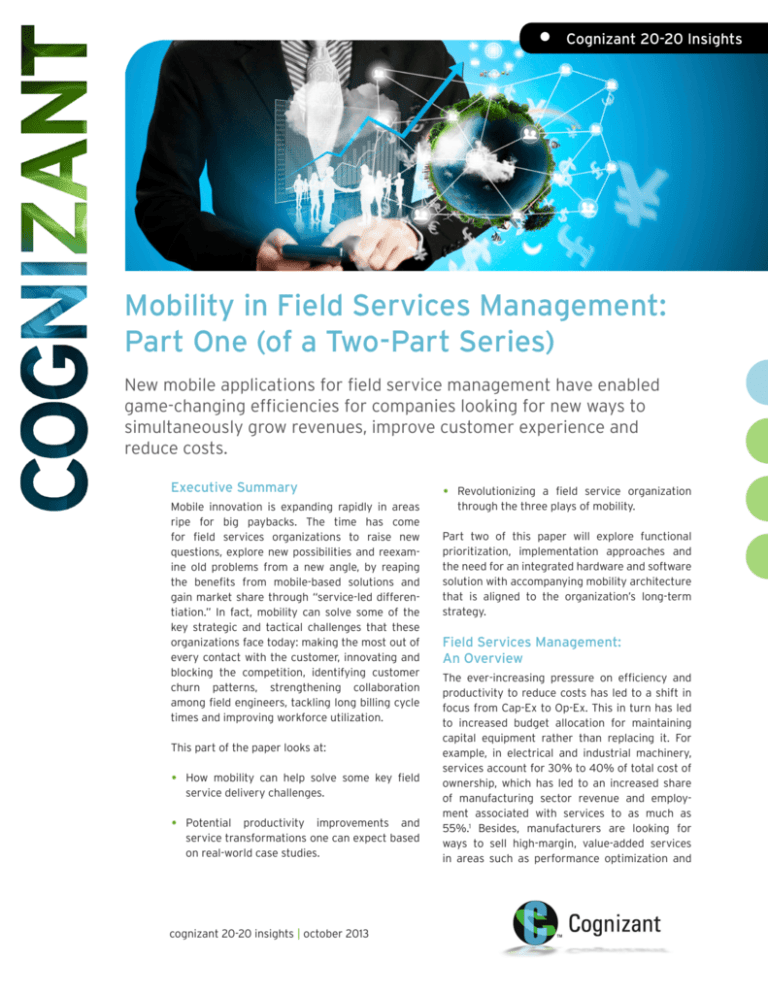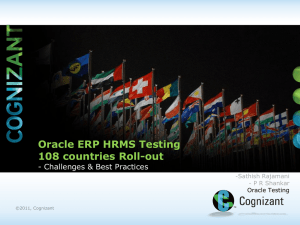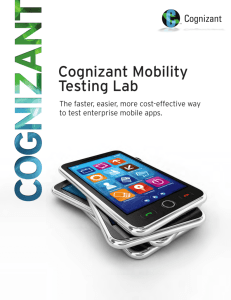
• Cognizant 20-20 Insights
Mobility in Field Services Management:
Part One (of a Two-Part Series)
New mobile applications for field service management have enabled
game-changing efficiencies for companies looking for new ways to
simultaneously grow revenues, improve customer experience and
reduce costs.
Executive Summary
Mobile innovation is expanding rapidly in areas
ripe for big paybacks. The time has come
for field services organizations to raise new
questions, explore new possibilities and reexamine old problems from a new angle, by reaping
the benefits from mobile-based solutions and
gain market share through “service-led differentiation.” In fact, mobility can solve some of the
key strategic and tactical challenges that these
organizations face today: making the most out of
every contact with the customer, innovating and
blocking the competition, identifying customer
churn patterns, strengthening collaboration
among field engineers, tackling long billing cycle
times and improving workforce utilization.
This part of the paper looks at:
•
How mobility can help solve some key field
service delivery challenges.
•
Potential productivity improvements and
service transformations one can expect based
on real-world case studies.
cognizant 20-20 insights | october 2013
•
Revolutionizing a field service organization
through the three plays of mobility.
Part two of this paper will explore functional
prioritization, implementation approaches and
the need for an integrated hardware and software
solution with accompanying mobility architecture
that is aligned to the organization’s long-term
strategy.
Field Services Management:
An Overview
The ever-increasing pressure on efficiency and
productivity to reduce costs has led to a shift in
focus from Cap-Ex to Op-Ex. This in turn has led
to increased budget allocation for maintaining
capital equipment rather than replacing it. For
example, in electrical and industrial machinery,
services account for 30% to 40% of total cost of
ownership, which has led to an increased share
of manufacturing sector revenue and employment associated with services to as much as
55%.1 Besides, manufacturers are looking for
ways to sell high-margin, value-added services
in areas such as performance optimization and
Building a Case for Mobility in Field
Services Management
both preventive and predictive maintenance.2
These business trends are key drivers prompting
manufacturers to focus on growing services as an
additional revenue stream.
The ever-increasing pressure on operating
margins and employee efficiency coupled with
increasing global footprint makes mobility in
today’s field service organization a critical,
enabling solution. A field service organization may
have a decentralized operating model, whereby
each business unit and/or geographical region
has its own systems and processes to serve customers. However, a shift to an integrated operating model with a centralized service information
platform would facilitate process harmonization
and collaboration and knowledge-sharing among
technicians and test analysts across geographies.
For example, a manufacturer’s field services
team could comprise engineers and analysts
who ensure uptime and availability of the
client’s equipment by offering various services.
Many industrial manufacturers offer specialized
services such as detailed analysis and reporting of equipment – i.e., life expectancy analysis,
vibration analysis, energy consumption analysis – in addition to the standard servicing of the
equipment. Regardless of whether this function is
in-house or contractual, the field service function is a crucial aspect of the business influencing
metrics associated with new customer acquisition
and customer retention.
This will support distinct differentiation and
competitive advantage by building intellectual
capital that the organization can then share
Field Service Management: A Functional Map
Project
Management
Field Services
CoE — Testing,
Analysis &
Reporting
Customer
Qualification
Req. - E-com/ & VerifiSales Unit
cation
Service
History
Asset
Inspection
Database
Specialized Tests
Collaboration
Blogs and
Threads
Logistics
Logistics
Parts
Inventory
Visibility
Contract &
Warranty
Billing & Expense
Automated Sales
Opportunities
KPIs &
Dashboards
Remote
Monitoring
Work
Estimation
Planning Skill, Part
& Sched- & Tool
uling
Reqmnt.
Diagnosis &
Testing
Analysis Tools
Discussion
Forums
Part
Returns
Field Service
Reports
Reporting Tools
Field Quote
Generation
Service Level Agreements
Employee Expense Claims
FSE Work
Allocation
Optmz.
Trend Graphs &
Derived Parameters
Test Analyst
Task Optimization
Live Chat Support/
Chat Room
Wiki Pages
Part Delivery
Scheduling
SoP &
Check
sheet
Real-Time
Spare Part Booking
Warranty Information
Time Sheet Filling
Customer Invoicing
Up Selling
Cross Selling
Renewal of AMC
Parts Catalogue
Productivity &
Utilization
Customer
Retention
Sales
Analytics &
Dashboards
Monitoring of
Operating Parameters
Data and Notifications
for Abnormal Trends
Corresponding Tests
and Services
Field service business is well-suited for mobility, as it includes complex processes with multiple interactions,
distributed activities and access to diverse information.
Figure 1
cognizant 20-20 insights
2
across the enterprise in real time. In such an
integrated model, mobility would improve key
business KPIs such as:
•
Field engineer utilization.
•
Field engineer productivity.
•
Order-to-cash cycle.
•
Customer satisfaction.
•
Cross-sell/up-sell services – service revenue.
•
Service contract renewal.
•
First-time fix – cost-of-service.
•
Self-service rate.
Leading analysts consider mobility to be a key
tool in the pursuit of field service excellence that
can help in gaining competitive advantage.3 The
key findings associated with the best-in-class
organizations studied in this report are:
•
49% have mobile tools in which field workers
can access schedules, work orders, resolution
information and parts information.
Challenges in Field Services and Potential Mobile Solutions
Challenges
Business Impact
Potential Mobility Solution
• Unacceptable repair times.
• Missing SLA commitments.
• Manual data entry errors.
• Brand
erosion.
• Lost sales.
• On-site access to knowledge portal and past
resolutions of similar issues.
• Electronic download and upload of forms and data.
• Dynamic scheduling.
• Access to skill roster.
• Lack of visibility to spare parts
and status of service call.
• Lack of visibility to field service
engineer’s location.
• Lack of
visibility.
• Integration of service functions (field, parts,
contact center).
• Google Map integration/GPS coordinates.
• Service request status update and alerts.
• Low technician productivity.
• Inaccurate capture of repair
costs.
• Inability to take advantage of
potential sales: cross-selling/
up-selling.
• Expiring maintenance contract.
• Loss of
business
opportunity.
• Automated forms and scanning devices.
• Automated capture of repair-related costs: spare
part costs, time-sheets and compliance with SLAs.
• Automated suggestion of follow-up services and
access to product/parts catalogue.
• Access to relevant maintenance contract
information.
• Long billing cycle times.
• High cost of holding parts
inventory.
• High cost of fuel and vehicle
maintenance.
• High cost of determining
accountability: tracking
down paperwork.
• Eroding
profitability.
• Real-time spare parts requirement and visibility
to in-stock parts.
• Electronic transmission of billing details.
• Onsite capture of customer signatures.
• Cost vs. SLA comparison for each service request.
• Easy retrieval of service history.
• Integration with vehicle diagnostic for improved
fleet management.
• Resistance to adopt new
technology.
• Resistance to be
monitored 24x7.
• Field
technician
buy-in.
• Automated expense report filing: reduce expense
claim cycle time.
• Designing role-based mobile apps.
• Access to knowledge portal on the fly.
• Outsourcing to third-party
service providers.
• Contractual workforce.
• Nonavailability of technician
with right qualifications.
• High attrition rate and
knowledge loss.
• Inconsistent
service
experience.
• Knowledge
management.
• Access to standard operating procedures and
check sheets for diagnosis.
• Collaboration with SMEs through online chat
and discussion forums.
• Access to knowledge portal.
• Lack of performance visibility.
• Lack of visibility on impact
of services on customer
management.
• Lack of senior
executive
support/
sponsorship.
• Business intelligence on mobile devices (including
customer-related metrics and impact of services
on financial metrics).
Figure 2
cognizant 20-20 insights
3
•
82% first-time service ticket fix.
•
15% decrease in service cost.
•
76% workforce utilization.
gaining visibility to spare parts inventory, invoicing and tracking of service orders to the ability
of taking advantage of cross-selling/up-selling
and contract renewal opportunities. The ability to
achieve business gains in these processes hinges
upon three plays of mobility in field services (see
Figure 3).
Challenges and Potential Solutions in
Field Services
Efficiency Play
A majority of field service engineers are on
the move and have to spend considerable
time searching for tools and information for
resolving service requests. Without real-time
access to the organization’s network at the point
of activity, field technicians have to resort to
collecting and capturing the information manually and later reentering it into the application.
This may lead to errors. It also reduces the speed
at which information moves through the supply
chain, causing delays in information availability
that may be critical for problem-solving, repair
and redeployment.
One of the primary objectives of enabling
field engineers (or third-party agents) with
mobile devices is to increase their efficiency and/
or productivity. The apps on mobile devices can
enable key activities such as:
Also, many field service organizations face the
challenge of ensuring consistent service quality
from field service technicians hired on contract.
Figure 2 (previous page) summarizes how mobility can address some of the specific challenges of
today’s field service organizations.
•
Dynamic service ticket (work order)
assignment, allocation and acceptance.
•
Time sheet filing.
•
Expense report creation and submission.
•
Routing/navigation information.
As a result, instead of seeing mobile devices as
a tool for personnel tracking and performance
monitoring, field engineers can use mobility to
generate substantial value by improving both
service and dispatch cycle times. These make
business processes more efficient, paperless and
user-friendly – leading to improved user adoption.
The Three Plays of Mobility in
Field Services
To maximize the value creation in field services
and deliver world-class service levels, organizations should examine the way they execute business processes across the value chain of field
services — from receiving the service request and
dispatching a skilled service engineer, conducting
niche engineering tests and analysis (if required),
Efficiency: Case in Point
One of our North America-based clients, a global
oil major engaged in exploration, refining and
marketing of oil and related products, was facing
efficiency challenges in its service request processes.
Mobility Plays in Field Services
$$
Consistency
$
$$$
Efficiency
Profitability
Mobility:
Driving Field Services Transformation
Figure 3
cognizant 20-20 insights
4
•
Creation, approval, acceptance and completion of work requests (maintenance, etc.) was
done using Microsoft Excel.
•
Standardization was minimal in work request
creation and data capturing.
•
Report generation was a difficult task.
The above challenges were addressed by enabling
electronic release application for the creation and
review of work requests using a handheld device.
This enabled dynamic allocation, acceptance and
completion notification of work requests. Our
client also reduced the order-to-cash cycle time
by enabling service engineers to create service
reports at client locations and get the necessary
approvals.
Transformation Play
A more strategic objective is using mobility for
global, scalable performance improvements.
Some of the key challenges, as faced by today’s
field services organization impacting the overall
health of business, are discussed below:
Consistent service experience: Increasing
margin pressure coupled with stringent SLAs
and increasing demand for value-added services
is driving organizations to partner with thirdparty field services organizations or hire contract
technicians. This makes providing a consistent
service experience to the customer challenging,
which in turn impacts the overall brand perception of an organization.
First-time resolution rate: To deliver a consistent service experience to a global customer
base, global manufacturers are exploring the
decentralized operating model of offering
value-added services, which fails to realize the
benefits of collaboration and knowledge-sharing.
For example, if a problem occurs in one region,
a field service engineer located elsewhere can
look for a solution from a different geography
and access the solution immediately, which would
lead to an improved first-time resolution rate.
in-house service personnel for appraising and calculating entitlement and settling a claim. Without
access to the correct information on the field –
e.g., which parts are covered under warranty, for
how long, etc. – giving away services for free will
be a likely possibility. A mobile-based application
enables:
•
Automated data capturing and uploading of
test forms.
•
Automated workflows.
•
Onsite service, repair, diagnostic testing and
disposition.
•
Access to service agreement and warranty
details of the product.
•
Onsite collaboration with SMEs.
These will reduce the impact of some of the
aforementioned challenges through simple reengineering of key field-related business processes.
Organizations are looking for these applications
on rugged industrial-grade devices and smartphones/tablets having the following functions
and features:
•
Plug-and-play accessories.
•
Barcode scanning and RFID-reading capabilities.
•
Real-time chat capability.
•
GPRS, Bluetooth/Wifi.
•
Visual library: tagging pictures of the equipment to report and highlight problems.
Transformation: A Case in Point
•
Third-party warranty claim adjusters: A thirdparty-based service model makes management of
parts, contracts and warranty leakages/insurance
claims challenging. Third-party personnel need
access to the same set of information as would
cognizant 20-20 insights
5
A global automotive major in the passenger
car market has developed a point-of-service
tool to aid technicians. The application, based
on a rugged mobile device, connects wirelessly
to the internal information library of the vehicle. This provides technicians access to online
catalogs, repair manuals and both technical
and reference libraries. The application connects to the vehicle, identifies it and retrieves
diagnostic test codes, enabling consistent
diagnosis and repair by independent dealers
and service providers.
•
In another example, one of our clients who is
a leader in facility maintenance in the U.S. has
an operating model with a mix of internal technicians and third-party personnel. The challenge in this model was to execute a job with
the best resource available and in a consistent
manner. We developed a multi-device delivery
platform for:
» Skill- and location-based service ticket
allocation.
» Workflows for diagnosis and resolution.
» Report creation with the ability to share the
problem on a common platform.
The solution also enabled the client to access
data collected by the third-party personnel during
problem resolution for immediate analysis.
Best Practices from Industry
•
•
QR codes and text-based service alerts:
Some of the best practices in the consumer
goods industry can be applied in the industrial manufacturing sector as well. Reminder
texts via cell phone when white goods are due
for service and QR codes to fetch additional
information about products are two examples.
Similarly, B2B customers can get reminders
and updates on various services relevant for
their equipment. For equipment information,
field service engineers can scan the QR codes
using their mobile phones.
Process integration: Some of the leading
field services firms are integrating the field
service management solution with their
clients’ remote condition monitoring software,
which leads to improved process integration.
Services can be configured based on alerts,
which leads to process automation and productivity improvements.
Disruptive Play: A Sense of Urgency
Field services firms have long been executing
proactive customer experience and operational
cost management. To maximize their market
share, however, they also need to uncover the
latent needs of their customers. This calls for an
innovation platform leveraging both competitive
intelligence acquired around competitors’ equipment and a firm’s expert knowledge scattered
across the organization, around field services.
Inability to capitalize on these limits the earlymover advantage of identifying and introducing
cognizant 20-20 insights
new test and service offerings before the competition does. Challenges such as a failure to identify customer churn patterns, lost opportunities
to cross-sell and up-sell services and long billing
cycle times are impacting the revenue growth and
profitability of field service organizations significantly. Industrial manufacturers could potentially
address some of these challenges and gain nonlinear growth by using the following levers:
Gaining competitive intelligence: To increase
market share, some industry players have begun
to extend their service offerings to cover competitors’ equipment. This gives them an opportunity
to gain competitive intelligence as well as differentiation by consolidating service providers and
therefore blocking out competition. During the
servicing of equipment, a field service engineer
may come across information such as:
•
Quality information on service frequency,
disruptions or failure rates.
•
Type of failures/issues in their own and in
competitors’ equipment.
•
Design concepts/parameter settings.
•
Ease in reparability and maintainability.
A field service engineer equipped with a mobile
device can help capture and store this information
centrally in a structured manner. This information
can be used as a learning tool, giving insight about
competitors’ products with strengths and weaknesses vis-à-vis the company’s own products. This
will support designing more robust products and
targeted service offerings, thereby maximizing
revenue potential, increasing customer retention
and boosting prospective customers.
Near field communication technology: Near
field communication (NFC) technology is on the
rise in the mobile space, providing exciting new
ways of doing business. Some of the avenues
where a field service organization can leverage
NFC to gain competitive advantage include:
•
6
Facilitating
a
knowledge-managementbased approach: A knowledge-based approach
to capture and share issues, problems and
solutions across a client’s BUs and regions
would lead to synergies and operational efficiencies. Wikis, blogs, discussion forums and
live chats are some of the tools that help in
building this knowledge-based platform. NFCenabled mobile devices will facilitate this
innovation platform by enabling instantaneous and seamless sharing of content with
a simple tap between any two devices. In field
services management, this technology can be
leveraged for:
to detect churn patterns for preventive actions.
It enables a range of advanced insightful information on key concern areas such as:
•
Specific issues customers can have with equipment, and approximations of when these
issues would surface.
» Sharing content from media applications.
•
Percentage of first-time fixes – at equipment,
issue and service-engineer levels.
•
Optimum length of appointments to achieve
first-time fixes – at equipment, issue and
service-engineer levels.
•
Customer satisfaction and loyalty performance at issue and service-engineer levels.
•
Likelihood of service contract renewals.
» Sharing a URL from the browser.
» Transferring documents and files.
» Sharing voice notes.
» Sharing contact information.
» Sending chat-room invitations.
• Enhance customer experience: In industries
where physical assets are present, NFC smart
tags can provide a brand new flow of specific
information both for customers as well as for a
field service engineer. An instant and seamless
information flow on tap such as service history
of the equipment, information around the annual
maintenance contract, warranty coverage, creation of real-time service requests during site
inspections and feedback mechanisms will not
only result in quick turnaround, but enhance the
customer experience as well.
•
Also, a field service engineer equipped with
a mobile device and enabled with a standard
test and service catalog, onsite inventory
visibility, contract renewal and quote generation capabilities can go beyond the routine
work of standard maintenance activity and
become an agent for generating additional revenues for the organization. This will improve
the conventional sales process by capitalizing
on customer face time.
Reduce billing cycle time: A printed invoice
could include NFC technology that would allow
customers to immediately pay securely with
an NFC-enabled smartphone.
Creating predictive analytics: Predictive analytics can lead to a more proactive customer retention strategy. Business can now analyze a very
large database of a customer’s service usage, service performance, spending and other behavior
patterns for better customer segmentation and
cognizant 20-20 insights
A daily or weekly batch notification on predefined
business rules and availability of this detailed
information on executives’ mobile devices will
facilitate timely and tailor-made service offerings.
Looking Ahead
Today’s field service organization strives to
achieve high performance, increased customer
satisfaction and revenue growth by transforming
its field force capabilities while remaining costeffective.
As discussed in this series, mobility is a key
enabler in responding to these market pressures
by bringing technician-focused tools to the field
and revolutionizing the service business practices
of the field service organization. However, merely
investing in technology does not ensure improvements in key KPIs. To be successful with mobile
deployments, organizations should:
•
Select the right FSM solution.
•
Adopt the right implementation approach.
Part two of our white paper will build on this foundation by outlining the functional and technical
parameters for a field service organization to go
mobile. Further, we will outline the implementation approach for developing an integrated solution that delivers a true competitive edge.
7
Footnotes
1
Manufacturing the future: The next era of global growth and innovation, McKinsey Global Institute,
November 2012.
2
Global Manufacturing Outlook: Fostering Growth through Innovation, KPMG, May 2012.
3
Aberdeen Group: Field Service 2012 – The Right Technician & Field Service 2011 – Mobility and the
Extension of the Service Enterprise.
About the Authors
Amit Kumar Singh is a Senior Consultant with Cognizant Business Consulting and is a core team member
of the Manufacturing and Logistics Practice. He has successfully executed a project advising the client
on developing a “service information platform” facilitating collaboration, process harmonization and
new services’ introduction for its field service organization. Amit has an M.B.A. from SP Jain Institute
of Management and Research, Mumbai and a bachelor’s degree in mechanical engineering. He can be
reached at Amitkumar.Singh@cognizant.com.
William (Bill) Cogdill is a Senior Director and Consulting Partner within Cognizant’s Manufacturing and
Logistics Practice. He has over 40 years of marketing, operations and supply chain experience and
is part of the consulting leadership team responsible for setting strategic direction for solutions that
address client challenges. Bill can be reached at William.Cogdill@cognizant.com | Linkedin: http://www.
linkedin.com/in/billcogdill | Facebook: William Cogdill (Bill Cogdill) | Google+: Bill Cogdill.
Karthik Natarajan is a Senior Manager of Consulting within Cognizant’s Manufacturing and Logistics
Practice. He has led numerous business transformation and strategic projects across the full spectrum
of business processes. His experience includes supply chain consulting, process reengineering and IT
strategy. Karthik is part of the consulting leadership team and has over 12 years of technology and business consulting experience. He can be reached at Karthik.Natarajan@cognizant.com.
About Cognizant
Cognizant (NASDAQ: CTSH) is a leading provider of information technology, consulting, and business process
outsourcing services, dedicated to helping the world’s leading companies build stronger businesses. Headquartered
in Teaneck, New Jersey (U.S.), Cognizant combines a passion for client satisfaction, technology innovation, deep
industry and business process expertise, and a global, collaborative workforce that embodies the future of work.
With over 50 delivery centers worldwide and approximately 164,300 employees as of June 30, 2013, Cognizant is a
member of the NASDAQ-100, the S&P 500, the Forbes Global 2000, and the Fortune 500 and is ranked among the
top performing and fastest growing companies in the world.
Visit us online at www.cognizant.com for more information.
World Headquarters
European Headquarters
India Operations Headquarters
500 Frank W. Burr Blvd.
Teaneck, NJ 07666 USA
Phone: +1 201 801 0233
Fax: +1 201 801 0243
Toll Free: +1 888 937 3277
Email: inquiry@cognizant.com
1 Kingdom Street
Paddington Central
London W2 6BD
Phone: +44 (0) 207 297 7600
Fax: +44 (0) 207 121 0102
Email: infouk@cognizant.com
#5/535, Old Mahabalipuram Road
Okkiyam Pettai, Thoraipakkam
Chennai, 600 096 India
Phone: +91 (0) 44 4209 6000
Fax: +91 (0) 44 4209 6060
Email: inquiryindia@cognizant.com
­­© Copyright 2013, Cognizant. All rights reserved. No part of this document may be reproduced, stored in a retrieval system, transmitted in any form or by any
means, electronic, mechanical, photocopying, recording, or otherwise, without the express written permission from Cognizant. The information contained herein is
subject to change without notice. All other trademarks mentioned herein are the property of their respective owners.






![CHEER Seminar Promo: 2nov2015 [DOC 142.50KB]](http://s3.studylib.net/store/data/007520556_1-22ae8f83ff74a912c459b95ac2c7015c-300x300.png)

